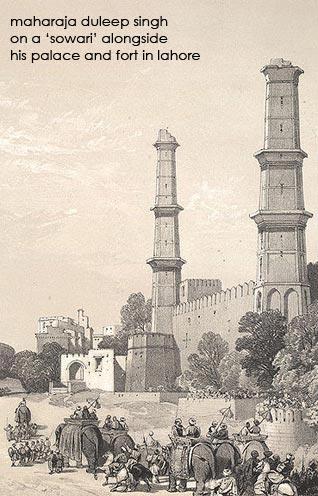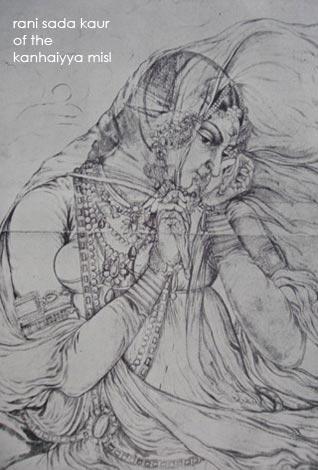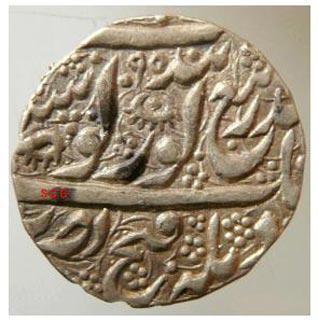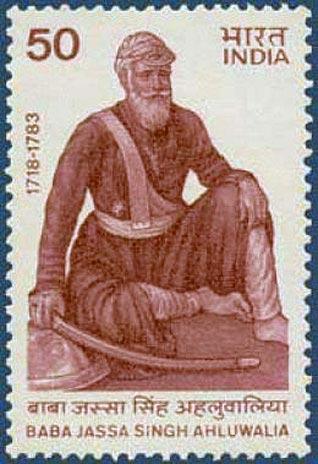Columnists
Sikh Misls, Part One: Yesterday, Today & Tomorrow
by I.J. SINGH
The Roundtable Open Forum # 56
Misls - Sikh confederacies - have a longer history than we think and are more critical to Sikh history than we give them credit for. We have forgotten their past, if we ever learned it. Naturally then we have diminished what they might tell us about today and tomorrow.
I start by deriving much of their history from the landmark entry by the eminent historian Hari Ram Gupta in Punjabi University's Encyclopaedia of Sikhism edited by Dr. Harbans Singh. Please explore that essay for historical detail. For me the issue emerged from recent conversations with Harpreet Singh of Harvard University, Harinder Singh of Sikh Research Institute, and T. Sher Singh of sikhchic.com. I will provide a tad longer comment than a thumb nail; my focus remains on connecting historical dots and mining that reality for lessons for today.
The word "Misl" apparently comes to us from Farsi to denote a unit or brigade of armed Sikh warriors and the territory controlled by them and from which they exacted tribute.
Depending on the context, the dictionary meaning of "Misl" varies from "similitude, alike or equal" (Steingass: Persian-English Dictionary); "tribe or race" (David Ochterlony); "territory occupied by a Sardar and his comrades" (Butay Shah); "voluntary association of Sikhs" (Wilson); even as an "encampment or deraah" (Syed Imam ud-Din Husaini).
Other
meanings found in history are "thaana" (Ratan Singh Bhangu), "friendly nation" (McGregor); "brotherhood" (Lawrence); "front garrison or border fortification" (J.D. Cunningham).
To me the varieties of descriptions try to capture the embryology and ontogeny of a nation.
According to some, the records of eleven such Misls (brigades), including the Sardars' fighting forces and territorial acquisitions were maintained at the Akaal Takht under the commander of the entire Sikh army - the Dal Khalsa. Later, a 12th misl arose in the Patiala region but it stayed somewhat independent of the overall command of the Dal Khalsa.
The misl system may date from the time of Guru Gobind Singh since his contemporary, Sainapati, has used the term, but it remains a largely 18th century reality. The eleven, and later twelve, misls were organized in two large commands - the Buddha Dal and the Taruna Dal, with an overall Commander-in-Chief of the Dal Khalsa.
The Dal Khalsa remained a loosely knit confederacy with no written constitution and every chief (Sardar) maintained his autonomy. Any amritdhari Sikh could join and had the option to shift from one misl to another. The ultimate controlling authority was the Sarbatt Khalsa that convened twice a year - at Vaisakhi and Diwali -- with the Akaal Takht as the symbolic capital
of the new nation.
In time, Ranjit Singh, leader of the Sukhercharia misl prevailed, consolidated his power and successfully liquidated all misls north of the Sutlej. From this he was able to forge a powerful empire that ruled a large swath of north India extending far into Afghanistan and Kashmir.
Ranjit Singh ruled with great sagacity but, not wanting competing powers around him, deliberately undermined neighboring misls as well as the authority of the Akaal Takht. That is some of his unfortunate legacy that continues to haunt us today.
The British annexed Punjab about a hundred years after they acquired the rest of India. The control of Sikh institutions, too, passed to them. It took an entirely non-violent (on the part of the Sikhs) but titanic struggle to wrest control of the historic gurdwaras of Punjab from the British and return it to the Sikhs.
Ceding control of Sikh institutions to Sikhs came with a price - legislative enactment of laws to govern the newly formed Shiromini Gurdwara Parbandhak Committee (SGPC) and later also the DGMC for gurdwaras in Delhi and surrounding regions.
This meant that the self-governance that was inherent in Sikh doctrine and spirit and was promised by law, passed into the hands of a legislatively and politically derived bureaucracy. This has some benefits but they are more political than religious.
Now the newly emerging global village is adding another complexity that some view as a massive complication.
The past 150 years have seen an exponential growth in Sikhs migrating from their traditional
bastion in Punjab and India to all corners of the world. Sikhs are now found in substantial numbers in the Americas, Europe, Africa, Asia and even the remotest places in this world.
Sikh diaspora is much like that of the Jews - there is not a corner of the world where Sikhs are not. This worldwide diaspora of Sikhs reminds me also of the large but scattered nations of the Native Americans.
The growing reality of a new world order has brought us beyond our borders in Punjab and India.
But we no longer have the misls that helped us act powerfully and in unison in our interests.
Do we now evolve a new definition of what a misl is and then into a new collective of misls? I believe we must.
This would then give new reality to Sikhs as a nation without borders. History tells us that misl leaders of the 18th century met twice a year to hammer out issues that Sikhs faced as a people.
They acted in concert without diminishing the independence and suzerainty of each other. They met as collaborating equals at the Akaal Takht. Thus was a new nation born.
Without this model of functioning Maharaja Ranjit Singh might not have been possible - surely, he would not have been able to create the uniquely successful Sikh Raj.
In our present reality, this seems like an excellent governing model to emulate. It might even
invigorate our five Takhts, including the Akaal Takht, to chart a new role in the uncharted waters of today.
What do we see when we look at many religions across the world? Christianity is fissured into over 200 sects and denominations. It is practiced in Rome very differently from how you see it in Latin America, United Kingdom or even in India.
The face of Islam varies with much divergence from Pakistan to the Middle East and onwards into America or Canada.
I could make similar arguments for Hinduism, Buddhism or any of the other major religions of the world.
We Sikhs are a young religion. But even now, after only about 150 years in the diaspora, I find strains and lines drawn among Sikhs of various nations. Our understanding of our faith is differently interpreted. How do we interpret the role of institutions that are Punjab- and India-based and seem to be as either hostage to local political realities or not understanding of our special needs and circumstances.
Yes, thinking globally, acting locally and starting small, may be the answer.
We are all influenced, shaped and guided by the fundamentals of our faith, socio-cultural realities and the legal ambiance which nurture us. It seems to me inevitable that Punjab-based Sikhs and their counterparts outside India will continue to grow apart from each other.
We need to live by our local realities and laws and not have our lives controlled by a remote bureaucracy in a distant part of the world. Much as different states and provinces find an equal voice in a national legislature, we in the diaspora, too, need representation and to be assured of an equal and (semi) autonomous place at our religion's table.
A workable way then it seems is to look at global realities as the new misls of today that could convene as the Sarbatt Khalsa as they used to.
This would provide us representation that is the first but critical step towards self-governance, accountability and transparency - values that the Gurus bestowed to us and remain the bedrock principles of any civilized society. These are values that we won at great cost but forgot to nurture in the Indian political-cultural milieu.
I can see Sikh misls - Singaporean, Kenyan, Thai, Punjabi, British, American, Pakistani or Canadian, among others, cognizant of their own interests and convening together in a Sarbatt Khalsa in the larger interest of Sikhs worldwide.
Yes, I seem to be pushing for a Misl Amriki (American), Misl Angrezi (UK) and all the way to a Misl Bharati (Indian) or Misl Punjabi (or better yet, Misl Haryanvi, Misl Mumbai or Bangalori, etc), since the Bharti Missl would otherwise become an overwhelming, looming presence because of its sheer numbers.
I am asking you to keep in mind that these and many misls more collectively make up the Sikh
reality today that is greater than the sum of the parts.
Recreating such a Sikh nation from this model of our history would also mean that it would be harder for the bureaucracy of any nation either to dominate or undermine our existence. By recognizing our misl-based structure that is semi-autonomous we could then legitimately and automatically evolve into a nation without borders. These are obvious pluses.
If we can envision the many-splendored global bouquet that the Sikh-world now presents, it would bring to us and to today's global village the greater and richer reality of Sikhi.
Dr. Jaswant Singh Neki has explored some of these issues as have I in The Sikh Review as well as elsewhere, including sikhchic.com. One can easily design a model for an appropriate bureaucracy; how best to recreate the grass roots is my issue here today.
Today, let's explore the misl system as a model. I have left out one formidable problem that is not easily overcome or swept aside: How membership in each misl would be regulated.
In the 18th century the single most important criterion for enrolment was being an amridhari male. What should requirements now be? Would the leader of the misl come by democratic elections?
Keep in mind that criteria for membership or leadership in democratic political systems are not always quite so simple. I illustrate my concern by a simple example. Many of us - immigrants to the USA - now enjoy largely equal rights and obligations except that, not being American born, the Presidency of the country is not open to us. I raise this not because each of
is hankering after the office but because it is pertinent here. Many models for self-governance are available. Democracy can be a pretty messy system except that it is better than the alternatives.
These matters demand careful and thoughtful discussion. I promise to soon explore these caveats in Part II of what we have started today.
Sikhs are nation builders and history-making people. We can neither repeat the past nor can we bury it, but we can reshape the present with it.
To me, the history of the Sikh Misls has profound lessons in the art of nation building that are just as true today as they were in the 18th century.
We must be ready to change and accommodate new realities while remaining true to our unchanging traditions and truths. These are the lasting lessons of history.
Our challenge? How to make this into an action item?
I invite readers to share your thoughts on the aforesaid, as part of the Roundtable this week, before we venture into the more difficult issues next week. Please post your comments below.
[Next Week: Part Two ...]
ijsingh99@gmail.com
January 5, 2011
Conversation about this article
1: Gur Singh (Chicago, U.S.A.), January 05, 2011, 11:08 AM.
We have so many places where global Sikhs get together. Now sikhchic.com wants to create one more. Funny isn't it? The best idea would be to work on the existing institutions like the S.G.P.C., etc. and evolve them into functional institutions. I support that any political party in India should not be allowed to contest S.G.P.C. elections. Secondly, the S.G.P.C. needs to be broken down in Punjab at the district level so that it is not stronger in numbers than any other misl. The bigger districts should be broken at the tehsil level. Other nations in the diaspora should also develope a similar formula in terms of representation. Start with the gurdwara as a basic unit and then get a fixed no. of gurdwaras to select one representative. The concept of Takht jathedars is most illusive and has the potential of destroying the community. Yeah, I agree that Amritdhari Sikhs should be allowed to represent us. But sehajdharis should have a vote too. The definition of sehajdhari should include all those individuals who believe in the Ten Gurus AND in the 11th Guru as the Living Spirit of the Gurus. I would like our reps to be seen in the full uniform of the Khalsa. Moreover, the presence of the sehajdhari Sikh sangat will keep the arrogance of ignorant amritdharis in check, which would help the new format not to have the same fate as the S.G.P.C. If the S.G.P.C. was really funcitonal, this topic would never have arisen. Also one more thing, who is amritdhari? Some one who has been having full saroop for a minimum of 10 years and following Sikhi in its full principles as described in the Guru Granth Sahib and the Rehat Maryada?
2: Inni Kaur (Fairfield, CT, U.S.A.), January 05, 2011, 2:47 PM.
Thank you, Inder, for initiating this thought-provoking must-have conversation. I have just started studying the Misl period and am totally in awe of its structure, etc. I look forward to a healthy discussion on this topic.
3: Sangat Singh (Kuala Lumpur, Malaysia), January 05, 2011, 3:19 PM.
I remember reading somewhere, maybe 50 years ago, that if by chance members of the warring Misls came face to face in the 'parkarma' of Harmandar Sahib, they would embrace each other like long lost brothers.
4: Gurinder Singh (Stockton, California, U.S.A.), January 05, 2011, 5:32 PM.
Sikh misls used to get together as Sarbatt khalsa each year at the Akal Takht. They used to have a gurmatta in the presence of Guru Granth Sahib and Dasam Patshah ka Granth. All weapons were left out and they entered Harmandar Sahib parkarma as brothers.
5: M.K.S. (New York City, New York, U.S.A.), January 05, 2011, 5:32 PM.
Dr. IJ Singh ji: Thanks for another well written article. While I agree with the spirit of the article and the fact that the Sikhs are a nation no matter which part of the world we live in and thus the need to have a bond with other Sikh communities. I prefer the 'munji' way of creating the bond over misls. In my mind the misl system, since it morphed into defending or annexing a geographic area, created rifts among Sikhs even in times which were a few years after the Gurus and when the misls were in close proximity of each other. On the other hand, the munji system which was started by the Gurus was meant to spread the word of the Gurus and do Sikhi parchar. And in many ways created a group of people who felt confident to create the misl system and were ready to take on the mighty Mughal empire and establish the Sikh Raj. I don't want anyone to misunderstand me - let's not confuse this with the Khalistan debate. I don't oppose any Sikh who wants a Khalistan if he/she feels Sikh rights are not safeguarded within the political system of where he/she resides. And I don't oppose any Sikh who does not want a Khalistan because he/she is comfortable with the political system of where he/she resides. The question I believe is how best to connect the blossoming Sikh communities around the world into a NATION. While I don't reject the idea of the misls, I believe it would work better and be more effective if it operated under the munji umberella.
6: Raj (Canada), January 05, 2011, 6:51 PM.
Great article. It's about time we start safeguarding our rights as residents of different political nations and still be part of the "Sikh Nation". I have commented before on this site that no organization ... read S.G.P.C. or the Akalis or Congress - can protect us from pogroms or genocides unless we have a powerful voice on the world stage. The structure and constitution of such organization should be discussed and debated. May be this is the start of something wonderful.
7: Mohan Singh (Toronto, Ontario, Canada.), January 06, 2011, 11:44 AM.
I agree with MKS. Munjis were introduced by Guru Amardas for preaching and the misl for the defence of Sikhs, Sikhi and Punjab from invaders. Today we have complex issues concerning Punjab and Sikhs/ Sikhi around the world. I suggest an online Global Sikh Parliament with local mini parliaments in major cities around the world. In India there is an online YoungSikhLeaders.org with over 5000 members and is creatively active. All male members are with sabat surat.
8: Taran (London, United Kingdom), January 06, 2011, 12:18 PM.
It's a great idea which has been buried in history! But I seriously think that we already have enough failed institutions and political bodies which are good for nothing! But having said that, if sikhchic.com would initiate something, I would be happy to join the cause.
9: H.S. Vachoa (U.S.A.), January 06, 2011, 3:59 PM.
The political and social reality of Sikhs needs to be based upon the fundamental element of military necessity and bearing amongst Sikhs which has been crucial in making the Sikh Misls.
10: I.J. Singh (New York, U.S.A.), January 07, 2011, 5:04 PM.
Perhaps I can restate in different words a question that underlies my column here. We Sikhs now enjoy a very different global existence. Please explore with me what would be the face of a Sarbatt Khalsa today - race, color, gender, worldly qualification and success, commitment to Sikhi, definition and sense of self, and what kind of a world=view would such a Khalsa exhibit. How will we see its Punjabi roots in context? How will gender differences play? How do you see this Sarbatt Khalsa function in ths complex society and define a place for itself?
11: Ravinder Singh Taneja (Westerville, Ohio, U.S.A.), January 10, 2011, 6:51 AM.
We have tried - and failed, so far - to address the complexity of our global presence. Of late, one such attempt has been made by the World Sikh Council - America Region, which seeks to address similar concerns. There are other organizations as well, both in the U.S. and elsewhere that have the right intent. Only time will tell how successful we will be, but the fact that we are talking about it is a good sign.






